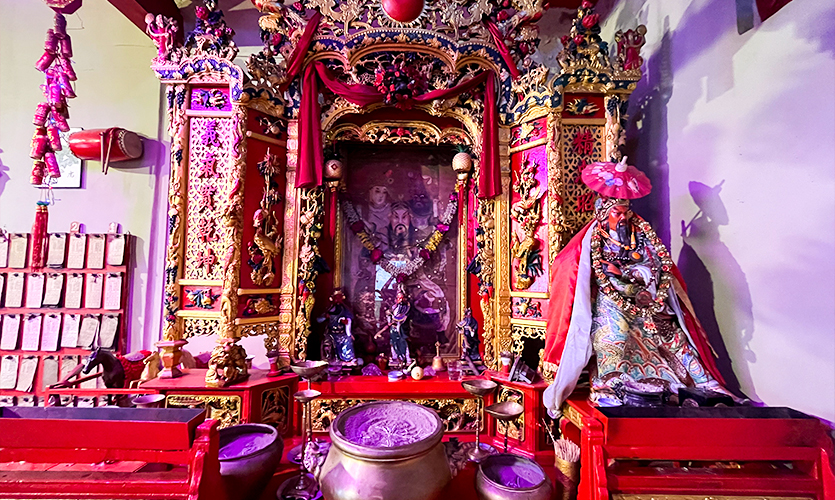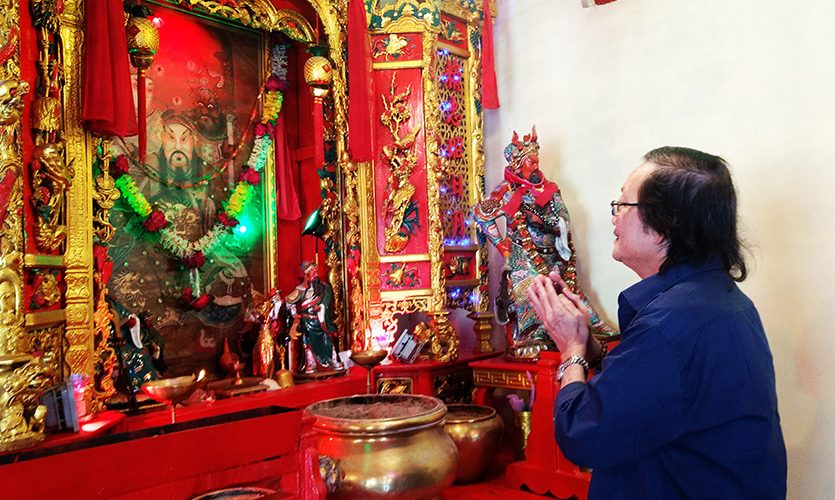Amidst all the smoke, traffic and hustle, the Kwan Kung temple is a protected remnant, which assures that not all is lost in Mumbai.
Albert Tham, the caretaker of this Chinese temple, walked us through its history that has been tucked away in the erstwhile Chinatown of Mumbai, Mazagaon.
Mumbai has always been a mosaic of diverse cultures, religions and ethnicities. In the 1800s, the Chinese too joined the vast diversity of the island when settled in Mazagaon and Kamathipura. They migrated to India looking for job opportunities in the shipping dockyard under the East India Company, and to escape communist rule in the war-torn China. The Chinese first enrolled in institutes to hone their skills, and were then employed at the dockyard once there was an opening.
The See Yup Koon of Canton, South China, soon set up ‘dharamshalas’ for these community members in Mazagaon. The streets were lined up with shops, Chinese restaurants by chefs, the choicest beauty salons, dental clinics, and finally, the Chinese temple in 1919. Albert Tham, also a member of the See Yup Koon community, narrated how his grandfather had similarly sailed down to India to work in the shipping companies. Unlike his father and grandmother, Albert was born and brought up in Mumbai, and fluently converses in Marathi, English and Hindi; although not Chinese!
Mazagaon: Mumbai’s Chinatown
Hidden away in the quaint lane of dockyard, the two-storey Kwan Kung Temple is painted in shades of scarlet with gold carvings. As you climb up the stairs to the shrine, you can hear the melodic Chinese chants and smell the aroma of the joss sticks in the air.

The walls of the stairway are covered with intricate murals of Fuk, Luk and Sau – the Chinese gods of blessing, longevity and prosperity. Albert describes them as the ‘Three Wise Men’, explaining that they are metaphors for the stages a human encounters in his life. The ground floor is dedicated to the goddess of mercy, peace and wisdom – Kwan Yin.
The wooden staircase leads you to the altar adorned with divine dragon motifs, paper lanterns, wind chimes and Chinese calligraphy.
The temple pays homage to Kwan Tai Kwon, the god of war, wealth and protection who was worshipped by kings and emperors in ancient times. Before him sits a delicately carved idol of Guan Gong, the god of justice and courage.
After praying and offering fruits and chocolates to Kwan Tai Kwon, worshippers often shake the Kau Chim (fortune sticks) to know their fortune from the bamboo cards. They also toss the Jiaobei (kidney shaped moon blocks), denoting the yin and yang, to ask for favours. If the blocks fall on the opposite sides, it is believed that your favour shall be granted, if not, then that is something you must avoid!
Tragically, in 1962, the Indo-China war broke out, forcing a majority of the Chinese back to their country since they would no longer be employed at the dockyard. The Chinese who had set up their own businesses stayed back, and continued to live in the See Yup Koon lodges.
Hindi-Chini Bhai-Bhai?
Vinayak, who is highly fascinated by Chinese culture and is an avid follower, often visits the temple along with Albert. While talking about the temple and its rituals, he highlighted the similarities between Indian and Chinese traditions. Since the temple is situated in Mumbai, it is interwoven with Indian traditions and visited by Hindus too.
Vinayak pointed out how both Indians and the Chinese follow the lunar calendar. While Indians celebrate Diwali during the New Moon, the Chinese celebrate the Spring Festival (Shin Yen). Both these festivals are celebrated fortnightly. In India, the end of the fortnight marks Guru Nanak Jayanti, while the Chinese celebrate the lantern festival.
Similarly, Onam, the harvest season festival of Kerala has boat races, which can be witnessed during the dragon boat festival of China too.
‘Modern Love Mumbai’ In Kwan Kung
On this note of tying cultures, Vinayak gave his two cents on the Mumbai Dragon episode of Modern Love Mumbai, directed by Vishal Bharadwaj. Bharadwaj was in contact with Albert and his friends to research about the history of the temple and design the set for the episode. However, much to their dismay, many interesting aspects about the temple were edited in the final cut.
Vinayak describes how the lanes were decorated with red lanterns and a Chinese crowd filled the streets. Since they were shooting for the Chinese New Year, a dragon dance was also created, which did not make the cut. In his opinion, because the episode was only 45 minutes long, the creators could not do justice to the temple’s history and portrayed an Indianised version of the story.
Nevertheless, he enthusiastically shared how the invention of the chicken corn soup was accurately shown in the episode.
The Mumbai Dragon episode underlines how the Chinese have adapted to the lifestyle of Mumbai by learning Hindi, and how local Indians have also grown closer to the Chinese culture.
Divided By Borders, Not Culture
Albert Tham shared how there has been an increase in intercaste marriages, where Chinese men have married Hindu and Christian women, and vice versa. The spouses often adopt each other’s religions and visit the temple together. Many like Vinayak have taken great interest in the Chinese language, and have researched in depth about their history and culture.
Alas, only a handful of Chinese families remain in Mazagaon currently. Ever since the 1962 war, the community has seen a drastic drop in the number of community members living in Mumbai. Today, there exist only about 1000 members, who are all scattered in different parts of Mumbai like Mira Road, Borivali and Andheri.
Born in India, Albert was alienated from his own culture. What he knew about Kwan Tai Kwon was limited to the stories he heard from his mother. He took it upon him to read and enlighten himself about the culture while looking after the temple.
He shares how he read the book ‘The Three Kingdoms’, which outlines the history of Kwan Tai Kwon and his emergence to interpret his teachings. Albert believes that even though he belongs to Chinese descent, he does not have to strictly follow that religion only. “You must be in sync with God,” he says.
For him, India has been his only home and he has never wished to relocate. Just like his ancestors who stayed back after the war, Albert feels connected to Mazagaon and specially to the temple, which he visits every Sunday. He organises the Chinese New Year with others at the temple with pomp and show, which is graced by at least 500 visitors on that day every year. They offer wine, fruits, and cakes, and dance around the lantern lit lanes.
This perfectly summarises what the temple stands for today. Much was lost after the war and many enemies were made, but we are linked with China through the rich history of trade, culture and the practice of Buddhism, and it lives on till date. They created a taste for spring rolls on the Indian menu, porcelain, furniture, silk, and paintings, and left behind this dainty Chinese shrine as a memoir. Despite the geo-political conflict, the Chinese still live peacefully amongst us and practise similar rituals.
We stand divided only by borders.










